Certifico ADR 2017.2 Build 0 | Maggio 2018
Certifico ADR 2017.2 Build 0 | Maggio 2018
Software trasporto merci pericolose ADR e rifiuti ADR
9a Edizione (2001/2003/2005/2007/2009/2011/2013/2015/2017)
14/05/2018: 2017.2 - Build 0
Software trasporto merci pericolose ADR e rifiuti ADR
9a Edizione (2001/2003/2005/2007/2009/2011/2013/2015/2017)
14/05/2018: 2017.2 - Build 0
Multilateral Agreement Under paragraph 1.5.1 of ADR, concerning the transport of UN 2672 ammonia solution in rigid and composite IBCs
1. By derogation from the requirements of section 4.1.1.10, IBC03, UN 2672 ammonia solution with up to but not more than 35% ammonia may also be carried in rigid or composite plastics IBCs of types 31H1, 31H2 and 31HZ1.
2. The IBC shall be provided with a device to allow venting during carriage. The inlet to the venting device shall be sited in the vapour space of the IBC under maximum filling conditions during carriage and shall meet the provisions of section 4.1.1.8 of ADR.
3. The IBC (s) shall only be carried in an 'open vehicle' as defined in chapter 1.2.1 of ADR.
4. This derogation shall not be applicable to carriage through the Channel Tunnel.
5. The consignor shall enter in the transport document: "Carriage agreed under the terms
of section 1.5.1 of ADR (M310)"
6. This agreement shall be valid until 31 January 2022 for the carriage on the territories of those ADR Contracting Parties signatory to this agreement. If it is revoked before then by one of the signatories, it shall remain valid until the above mentioned date only for carriage on the territories ofthose ADR Contracting Parties signatory to this agreement which have not revoked it.
Dublin, 25 January, 2018
For the Competent Authority in Ireland for ADR
| COUNTRY | SIGNED | REVOKED |
| Ireland | 25/01/2018 | |
| United Kingdom | 26/01/2018 | |
| Italy | 28/03/2018 |
Date of expiry: 1 February 2022 (corrected)
Multilateral Agreement in English
Explanatory letter in English
Decreto Ministero delle Infrastrutture e dei Trasporti 21 dicembre 2017
Struttura del decreto:
Art. 1. Definizioni ed acronimi
Art. 2. Approvazione imballaggi, grandi imballaggi e contenitori intermedi
Art. 3. Approvazione cisterne mobili e contenitori per gas a elementi multipli (CGEM)
Art. 4. Rilascio, rinnovo e vigilanza sugli organismi autorizzati/riconosciuti
Art. 5. Approvazione delle apparecchiature a pressione (con e senza marcatura «UN»)
Art. 6. Approvazione organismi ed esperti per attività previste da RID/ADR/ADN ed IMDG CODE
Allegato I
...
Art. 1. Definizioni ed acronimi
1. ADR: l’accordo europeo relativo al trasporto internazionale delle merci pericolose su strada, concluso a Ginevra il 30 settembre 1957, e successive modificazioni;
2. RID: il regolamento relativo al trasporto internazionale delle merci pericolose per ferrovia, che figura come appendice C alla convenzione sul trasporto internazionale per ferrovia (COTIF), conclusa a Vilnius il 3 giugno 1999, e successive modificazioni;
3. ADN: l’accordo europeo relativo al trasporto internazionale delle merci pericolose per vie navigabili interne, concluso a Ginevra il 26 maggio 2000, e successive modificazioni;
4. Codice IMDG: codice internazionale per il trasporto marittimo delle merci pericolose, adottato dall’Organizzazione internazionale marittima (IMO) con risoluzione A.81(IV) del 27 settembre 1965;
5. Convenzione CSC: Convenzione internazionale sulla sicurezza dei contenitori (CSC) adottata a Ginevra il 2 ottobre 1973, e sua esecuzione;
6. In tutti i casi in cui nel presente decreto si fa riferimento all’autorità competente, per tale si deve intendere il Dipartimento per i trasporti, la navigazione gli affari generali ed il personale (nell’articolato che segue denominato «Dipartimento») per la normativa prevista dagli accordi ADR/RID/ADN e il Comando generale del Corpo delle Capitanerie di Porto - Guardia costiera (nell’articolato che segue denominato «Comando generale») per la normativa prevista dal Codice IMDG.
Art. 2. Approvazione imballaggi, grandi imballaggi e contenitori intermedi dei capitoli 6.1, 6.5 e 6.6 dell’ADR/RID/ ADN e dei capitoli 6.1, 6.5 e 6.6 del Codice IMDG.
1. Gli organismi autorizzati dal Comando generale ed operanti ai sensi dell’art. 30 del decreto del Presidente della Repubblica 6 giugno 2005, n. 134, in materia di approvazione di imballaggi, grandi imballaggi e contenitori intermedi, di cui ai capitoli 6.1, 6.5 e 6.6 del Codice IMDG, previa specifica istanza presentata alla Commissione prevista dall’art. 13, comma 3 del decreto legislativo 27 gennaio 2010, n. 35 provvedono anche all’approvazione ed all’effettuazione delle prove di imballaggi, grandi imballaggi e contenitori intermedi, sia nuovi che ricondizionati, che recano la marcatura UN secondo le previsioni dei capitoli 6.1, 6.5 e 6.6 dell’ADR, del RID e dell’ADN e le ulteriori disposizioni impartite dal Dipartimento.
2. Gli organismi riconosciuti dal Dipartimento in base al comma 1 del presente articolo devono inviare alla Commissione prevista dall’art. 13, comma 3 del decreto legislativo 27 gennaio 2010, n. 35, entro il mese di febbraio di ogni anno una relazione delle attività svolte nell’anno precedente.
3. I Centri Prova Autoveicoli (CPA) e gli Uffici Motorizzazione Civile (UMC) del Dipartimento secondo le competenze loro attribuite, provvedono all’approvazione ed all’effettuazione delle prove secondo le previsioni dei capitoli 6.1, 6.5 e 6.6 del Codice IMDG e le ulteriori disposizioni impartite dal Comando generale, di imballaggi, grandi imballaggi e contenitori intermedi, sia nuovi che ricondizionati, che recano la marcatura UN.
4. I Centri Prova Autoveicoli (CPA) e gli Uffici Motorizzazione Civile (UMC) del Dipartimento trasmettono copia delle certificazioni emesse al Comando generale.
5. Il Dipartimento invia annualmente al Comando generale un elenco dei Centri Prova Autoveicoli (CPA) e degli Uffici Motorizzazione Civile (UMC) che effettuano le attività di cui al presente articolo.
Art. 3. Approvazione cisterne mobili e contenitori per gas a elementi multipli (CGEM) del capitolo 6.7 dell’ADR/RID/ADN e del capitolo 6.7 del Codice IMDG.
1. Gli organismi appartenenti alla International Association of Classification Societies (IACS), ovvero autorizzati dal Comando generale ai sensi dell’art. 10, comma 4, del decreto del Presidente della Repubblica 6 giugno 2005, n. 134 in materia di approvazione e mantenimento in servizio delle cisterne mobili e dei contenitori per gas a elementi multipli (CGEM) e dei loro accessori secondo quanto previsto dal capitolo 6.7 del Codice IMDG, previa specifica istanza presentata alla Commissione prevista dall’art. 13, comma 3 del decreto legislativo 27 gennaio 2010, n. 35 provvedono anche all’approvazione e mantenimento in servizio delle cisterne mobili e dei contenitori per gas a elementi multipli (CGEM) e dei loro accessori secondo quanto previsto dal capitolo 6.7 dell’ADR/RID/ADN.
2. Gli organismi riconosciuti dal Dipartimento in base al comma 1 del presente articolo devono inviare alla Commissione prevista dall’art. 13, comma 3 del decreto legislativo 27 gennaio 2010, n. 35, entro il mese di febbraio di ogni anno una relazione delle attività svolte nell’anno precedente.
3. I Centri Prova Autoveicoli (CPA) e gli Uffici Motorizzazione Civile (UMC) del Dipartimento secondo le competenze loro attribuite, provvedono all’approvazione e al mantenimento in servizio delle cisterne mobili e dei contenitori per gas a elementi multipli (CGEM) e dei loro accessori secondo quanto previsto dal capitolo 6.7 del Codice IMDG e le ulteriori disposizioni impartite dal Comando generale.
4. I Centri Prova Autoveicoli (CPA) e gli Uffici Motorizzazione Civile (UMC) del Dipartimento trasmettono copia delle certificazioni emesse al Comando generale.
5. Il Dipartimento invia annualmente al Comando generale un elenco dei Centri Prova Autoveicoli (CPA) e degli Uffici Motorizzazione Civile (UMC) che effettuano le attività di cui al presente articolo.
Art. 4. Rilascio, rinnovo e vigilanza sugli organismi autorizzati/riconosciuti
1. Nelle more della revisione della normativa di settore, le Autorità competenti continuano ad effettuare, per gli organismi autorizzati/riconosciuti di cui ai precedenti articoli, le attività di rilascio e rinnovo delle relative autorizzazioni, nonché la vigilanza sugli stessi, ciascuna comunicando all’altra il calendario delle attività per l’eventuale attività congiunta.
2. Le disposizioni di dettaglio per lo svolgimento delle citate attività di rilascio, rinnovo e vigilanza, sono disciplinate con decreti dipartimentali/dirigenziali, da parte delle Autorità competenti, ciascuno nell’ambito delle rispettive competenze attribuite dalle vigenti norme.
[...]
GU n.12 del 16-01-2018
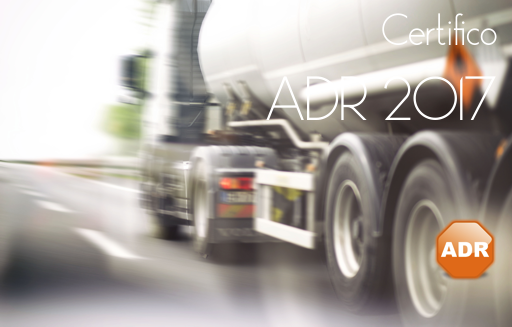
Software trasporto merci pericolose ADR e rifiuti ADR
9a Edizione (2001/2003/2005/2007/2009/2011/2013/2015/2017)
Tutte le versioni in Store
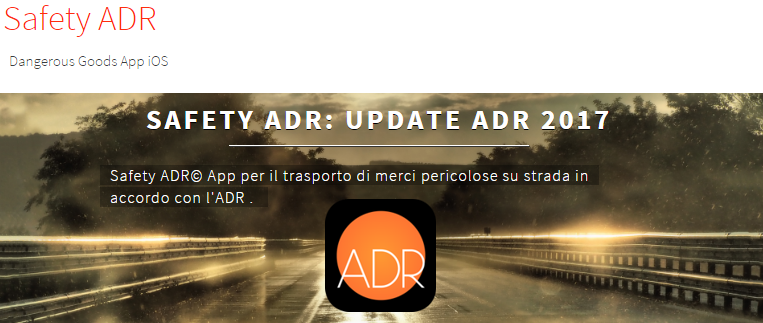
Dangerous Goods ADR 2017 iOS app
ADR: European Agreement concerning the International Carriage of Dangerous Goods by Road
ADR 2017 - Accordo europeo relativo al trasporto internazionale di merci pericolose su strada.
Questa versione dell'ADR è applicabile a decorrere dal 1° gennaio 2017 in coesistenza con ADR 2015 fino al 30 Giugno 2017.
In lingua italiana o inglese, Safety ADR© è un'app che consente di:
- visualizzare tutta la Tabella A cap. 3.2 ADR per ONU/denominazione/classe/altro;
- nuova ricerca per pannello arancio;
- compilare per ciascuna materia ADR il "Report materia" con il parametro "Safety" (1);
- compilare per ciascuna materia ADR la "Tremcards P.0" (2);
- avere news in tempo reale visualizzate direttamente in Home;
- consultare etichette ADR, classi, Kemler.
I documenti compilati, "Report materia" e "Tremcards P.0", sono archiviati automaticamente e possono essere stampati con Air Print o inviati via e-mail in formato PDF.
Report Safety
Il parametro "Safety" dà informazioni sull'Area di Sicurezza (A.S.), dipendente dal quantitativo della merce trasportata "Q" e dal codice "Kemler" corretta da un fattore "K", per la quale si ritiene che la merce trasportata debba essere debitamente delimitata a tale valore in caso di incidente che possa comportare un rischio per la salute e la sicurezza pubblica (leggere con attenzione il Disclaimer).
Report Tremcards P.0
La "Tremcards P.0" (Transport Emergency Cards - P.0) è formata da 4 pagine di Istruzioni Scritte ufficiali ADR + Pagina 0 di Informazioni Preliminari Certifico "P.0".
La pagina "P.0" è stata introdotta in aggiunta alle Istruzioni Scritte ADR per facilitare una migliore individuazione delle merci trasportate in caso di emergenza e come indicato in nota 2 di pagina 3 delle Istruzioni Scritte ADR per aggiungere "Ulteriori Istruzioni":
ADR 5.4.3 Nota (2) delle ISTRUZIONI SCRITTE:
"Le ulteriori istruzioni qui sopra indicate possono essere adattate in relazione alle classi di merci pericolose trasportate e al mezzo di trasporto."
Safety e Tremcards P.0 sono modelli depositati Certifico S.r.l. - Italia

Novita'
15.05.2017 - Update. 1.0.2
- 0002595: ADR 2017: Aggiornamento materie ONU
- 0002598: ADR 2017: Nuova etichetta "9A - Classe 9A pile o batterie al litio" e "simbolo pile-batterie litio"
- 0002550: ADR 2017: Correzione testo del "Parametro Safety" nel "Report Materia"
- 0002038: ADR 2017: Aggiornamento del report "Istruzioni Scritte"
- 0001429: Funzione di copia, stampa e condivisione etichette
- 0002599: Link UNECE
- 0002594: Adeguamenti ai nuovi dispositivi
- 0001538: Supporto 64 bit
- 0002600: Supporto al pannello standard di condivisione di iOS per i PDF dei report
- 0002537: Cambiamento indirizzo sede Certifico s.r.l. e anno
Prezzo: gratuito
Acquisto database ADR 2017: € 23,99 (Acquisto in app)
Categoria: Riferimento
Pubblicato: 15/05/2017
Versione: 1.0.2
Dimensioni: 16.9 MB
Lingue: Italiano, Inglese
Sviluppatore: Certifico s.r.l.
© 2000-2017 Certifico S.r.l.
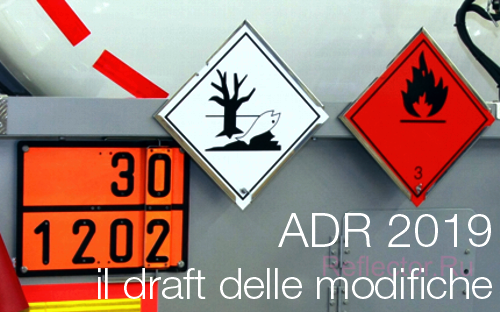
Reports ECE/TRANS/WP.15/240 (Secretariat) Draft amendments to annexes A and B of ADR
Date: 7 March 2018
Il 1° gennaio 2019 è prevista la modifica dell'Accordo europeo relativa al trasporto internazionale su strada delle merci pericolose (ADR 2019), disponibili dall'UNECE il draft delle modifiche.
L'ADR è sottoposta a un'ampia revisione ogni due anni. Le modifiche, notificate agli Stati contraenti dal Segretariato dell'ONU a partire dalla fine di giugno, possono essere respinte nel quadro di una procedura di opposizione fino a tre mesi prima della loro entrata in vigore l'anno successivo.
Non è invece possibile presentare richieste di modifica relative a singole disposizioni.
Per lo svolgimento di una consultazione a livello nazionale, le modifiche all'ADR devono essere sottoposte ai destinatari già prima della notifica.
In allegato il draft degli emendamenti degli Allegati A e B dell’ADR 2019 adottati dal WP15 dell’UNECE per l'entrata in vigore il 1° Gennaio 2019, per l’adozione seguirà la proposta ufficiale in conformità della procedura di cui all'articolo 14 della ADR.
Le notifiche degli Stati membri al draft dovranno essere comunicate entro e non oltre 1° Luglio 2018, con un riferimento al 1° gennaio 2019 come data prevista di entrata in vigore delle modifiche, che saranno in veste di "ADR 2019".
Di conseguenza, secondo le disposizioni dell'articolo 14, dell'accordo, le modifiche proposte agli allegati A e B, entreranno in vigore per tutte le parti contraenti il 1° gennaio 2019.
In allegato il draft in FR/EN delle modifiche previste.
Draft amendments to annexes A and B of ADR
Report: ECE/TRANS/WP.15/240
Date: 7 March 2018
Session WP.15: 103rd
At its 103rd session, the Working Party on the Transport of Dangerous Goods requested the secretariat to prepare a consolidated list of all the amendments which it had adopted for entry into force on 1 January 2019 so that they could be made the subject of an official proposal in accordance with the procedure set out in article 14 of ADR, which, following usual practice, the Chairperson would be responsible for transmitting to the depositary through his Government. The notification would have to be issued no later than 1 July 2018, with a reference to 1 January 2019 as the scheduled date of entry into force (see ECE/TRANS/WP.15/239, paragraph 66). This document contains the requested consolidated list of amendments adopted by the Working Party at its 100th, 101st, 102nd and 103rd sessions (see ECE/TRANS/WP.15/233, annex II, ECE/TRANS/WP.15/235, annex I, ECE/TRANS/WP.15/237, annex I and ECE/TRANS/WP.15/239, annex I).
Capitolo 8.2 ADR 2017
La materia sulla formazione professionale dei conducenti è disciplinata dall'ADR nel capitolo 8.2 relativo all’equipaggio del veicolo.
E' previsto che i conducenti dei veicoli destinati ai trasporti nazionali ed internazionali di merci pericolose su strada, devono essere muniti di apposito certificato di formazione professionale previsto dall'ADR, noto anche come "patentino ADR”.
Il certificato di formazione professionale è obbligatorio sia per i trasporti nazionali che per quelli internazionali, con veicoli con qualsiasi massa complessiva a pieno carico per quantitativi superiori a quelli di esenzione indicati nel capitolo 1.1.3.6.
Il certificato di formazione professionale è obbligatorio sia per i trasporti nazionali che per quelli internazionali, con veicoli con qualsiasi massa complessiva a pieno carico per quantitativi superiori a quelli di esenzione indicati nel capitolo 1.1.3.6.
Per la guida dei veicoli di qualsiasi massa (anche inferiore a 3,5 t) adibiti al trasporto nazionale o internazionale (in tutti gli Stati firmatari dell'accordo ADR) di merci, classificate pericolose ai sensi dell'ADR, che superano i limiti di esenzione è obbligatorio il possesso del certificato di formazione professionale (CFP).
Qualora il CFP non sia obbligatorio, il conducente, al pari di ogni altro personale che ha a che fare col trasporto di merci pericolose, deve aver comunque ricevuto un'adeguata formazione.
I conducenti conseguono il patentino dopo aver seguito i corsi di formazione ed aver superato i relativi esami scritti mediante l'utilizzo di questionari.
Il certificato di formazione professionale ha una validità massima di cinque anni.
Nell'anno che precede le relative scadenze, tutti i conducenti potranno ottenere il rinnovo del patentino esclusivamente se superano il corso di aggiornamento ed i successivi esami scritti corrispondenti alla formazione posseduta.
All’interno dello stesso certificato vi sono quattro abilitazioni: base e tre diverse specializzazioni (cisterna, esplosivi, radiottivi).
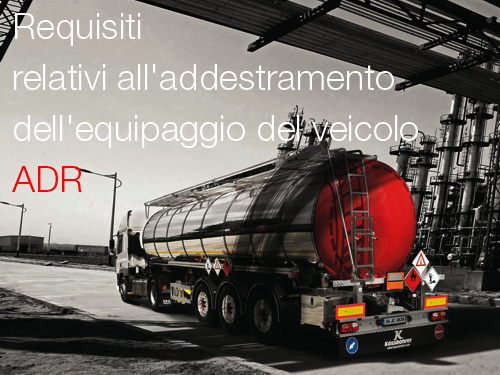
Il corso di formazione iniziale si compone di:
1. corso base, (obbligatorio) per il trasporto di merci pericolose con modalità diverse dalla cisterna;
2. corsi di specializzazione (facoltativi):
- corso di specializzazione per il trasporto in cisterne;
- corso di specializzazione per il trasporto di esplosivi della classe 1;
- corso di specializzazione per il trasporto di materie radioattive della classe 7.
Superato l’esame relativo al corso base, si può sostenere l’esame per le specializzazioni.
Non occorre il CFP conducente:
- nei casi di esenzione totale o parziale (ADR 1.1.3);
- quando i veicoli viaggiano scarichi, salvo le cisterne che non siano state preventivamente bonificate;
- in altri casi specifici.
Il certificato di formazione professionale:
- è redatto su modello UE ed è valido in tutti i paesi dell'UE e in quelli firmatari dell'Accordo ADR.
- ha validità di cinque anni e deve essere rinnovato frequentando un corso di aggiornamento e sostenendo un esame teorico, effettuato mediante questionari. I certificati rilasciati da uno Stato membro UE possono essere rinnovati anche negli altri Paesi UE;
- non può essere rilasciato a conducenti muniti di patenti speciali;
- è revocato o sospeso in caso di revoca o sospensione della patente cui è associato;
- può essere sottoposto a revisione da parte dell'UMC.
I titolari di CFP rilasciati da Stati esteri, anche extracomunitari, possono circolare in Italia purché:
- lo Stato che ha emesso il documento sia contraente dell’accordo ADR;
- il modello sia conforme a quello previsto dall’accordo ADR;
- il documento sia in corso di validità.
Si può convertire il CFP di uno Stato UE o di altro Stato col quale vi sia accordo di reciprocità
...
ADR 2017 Capitolo 8.2
8.2.2.4.
Programma di formazione iniziale
8.2.2.4.1.
La durata minima della parte teorica di ogni corso di formazione iniziale o della parte del corso di formazione polivalente deve strutturarsi come segue:
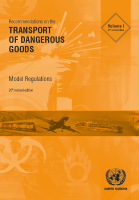
10 Ottobre 2017
UN Recommendations on the Transport of Dangerous Goods and Guiding Principles for use with the 20th revised edition.
These recommendations have been developed in the light of technical progress, the advent of new substances and materials, the exigencies of modern transport systems and, above all, the requirement to ensure the safety of people, property and the environment. They are addressed to governments and international organisations concerned with the regulation of the transport of dangerous goods. The Model Regulations cover the classification of dangerous goods, their listing, the use, construction, testing and approval of packagings and portable tanks, as well as consignment procedures such as marking, labelling, placarding and documentation.
This twentieth revised edition contains various new and revised provisions concerning, inter alia, articles which contain dangerous substances or articles; the classification of ammonium nitrate-based fertilizers; the classification of corrosive mixtures; the stabilization of fishmeal to prevent self-heating; cargo transport units containing lithium batteries and used for electricity storage; packing instruction for defective or damaged lithium batteries; the availability of test reports for lithium batteries; the transport of unstable substances under temperature control and the transport of vehicles powered by flammable liquids or gases, fuel cells or batteries.
Model Regulations 20a revised edition
Volume I
(Recommendations, Parts 1 to 3, Dangerous Goods List, Appendices and Alphabetical Index)
Volume II
(Parts 4 to 7 and Table of Correspondence)
United Nations, 2017

ADR 2017: applicabile ai trasporti nazionali di merci pericolose
Art. 1.
Modifiche all’art. 3 del decreto legislativo 27 gennaio 2010, n. 35
1. Le lettere a) , b) e c) dell’all’art. 3, comma 2, del decreto legislativo 27 gennaio 2010, n. 35, sono sostituite dalle seguenti:
«a) negli allegati A e B dell’ADR, come applicabili a decorrere dal 1° gennaio 2017, restando inteso che i termini “parte contraente” sono sostituiti dai termini “Stato membro”, come opportuno;
b) nell’allegato del RID, che figura come appendice C della COTIF, applicabile con effetto dal 1° gennaio 2017, restando inteso che i termini “Stato contraente del RI” sono sostituiti dai termini “Stato membro”, come opportuno;
c) nei regolamenti allegati all’ADN, applicabili con effetto a decorrere dal 1° gennaio 2017, così come l’art. 3, lettere f) ed h) e l’art. 8, paragrafi 1 e 3 dell’ADN, nei quali «parte contraente» è sostituito con “Stato membro”, come opportuno.».
G.U. n. 139 del 17.06.2017
Collegati
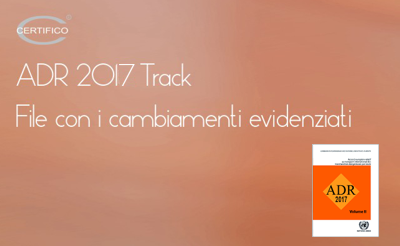
ADR 2017 file con i cambiamenti evidenziati /ADR 2017 (files with track changes)
ADR Accordo europeo relativo al trasporto internazionale di merci pericolose su strada Edizione 2017 (file con la traccia delle modifiche).
Nell'Allegato all'articolo i file dell'Accordo europeo relativo al trasporto internazionale di merci pericolose su strada edizione 2017, in formato pdf, con i cambiamenti in modalità evidenziata rossa.
La Versione mostra il testo dell'ADR 2017:
- con evidenziate le modifiche;
- nuove introduzioni rispetto all'ADR 2015.
Il testo eliminato non è visibile.
EN Version
Rev. 1.0 Aprile 2017
ADR è l’accordo internazionale per il trasporto di merci pericolose su strada, acronimo di “Agreement concerning the International Carriage of Dangerous Goods by Road”. L'Accordo è stato sottoscritto a Ginevra il 30 settembre 1957 sotto gli auspici della Commissione economica delle Nazioni Unite per l'Europa, ed è entrato in vigore il 29 gennaio 1968. Con il D.Lgs. 40/2000 (GU n. 52 del 03.03.2000) è stata istituita la figura del Consulente per la sicurezza dei trasporti di merci pericolose (Consulente ADR). Il D.Lgs. 40/2000 è stato poi abrogato dal D.Lgs. 35/2010.